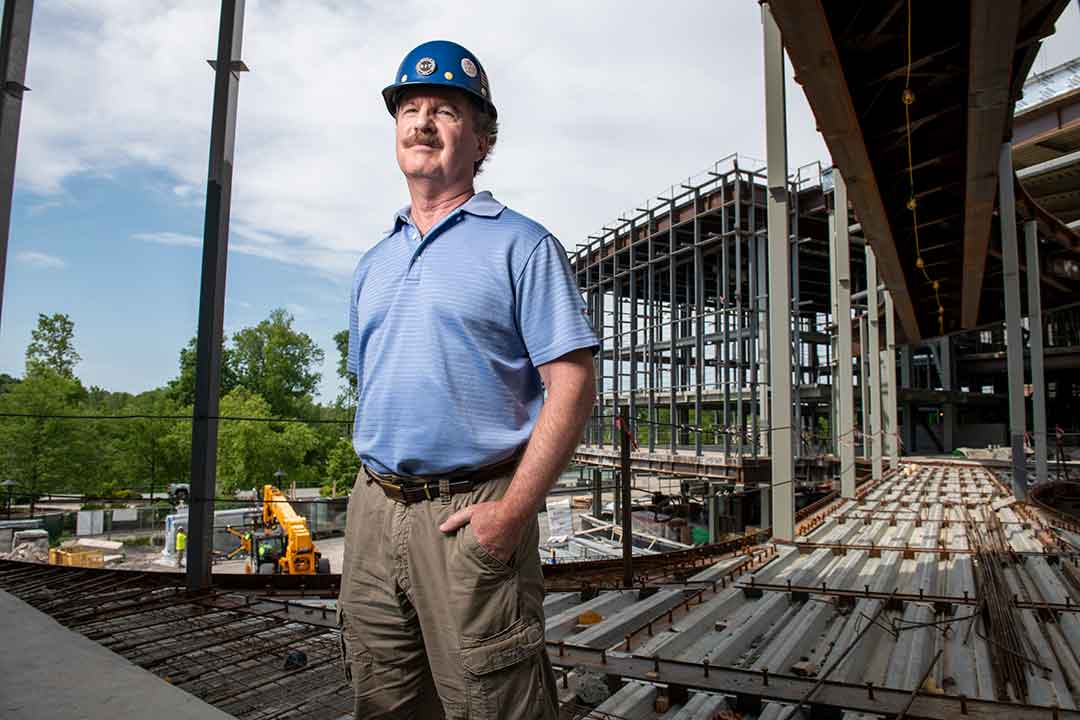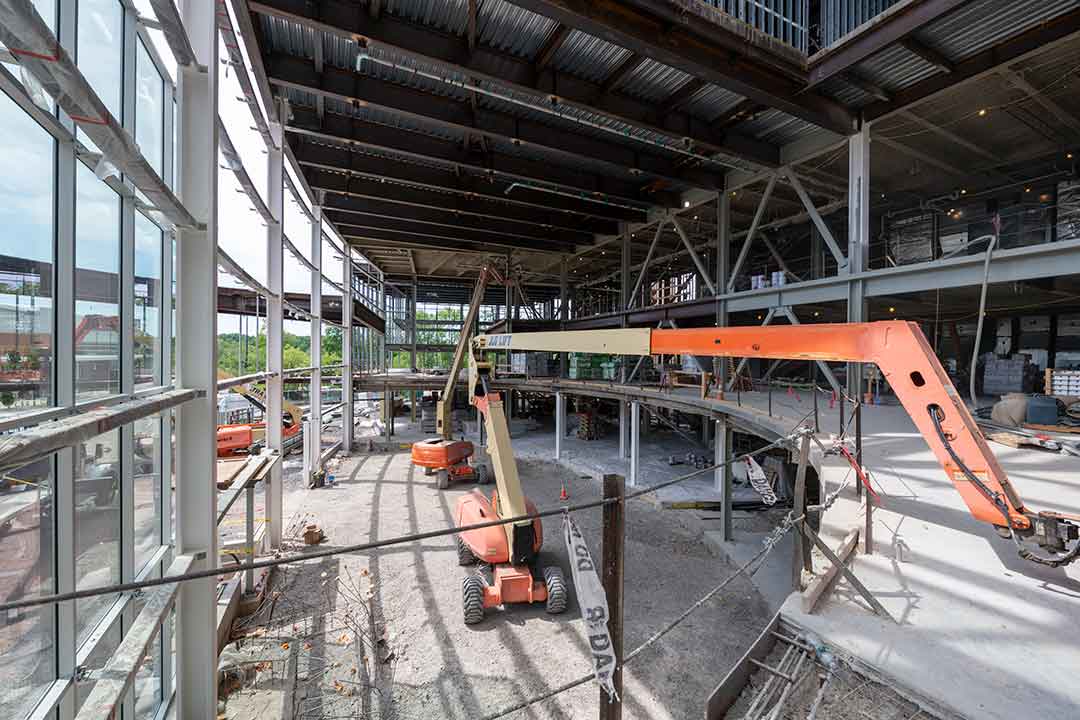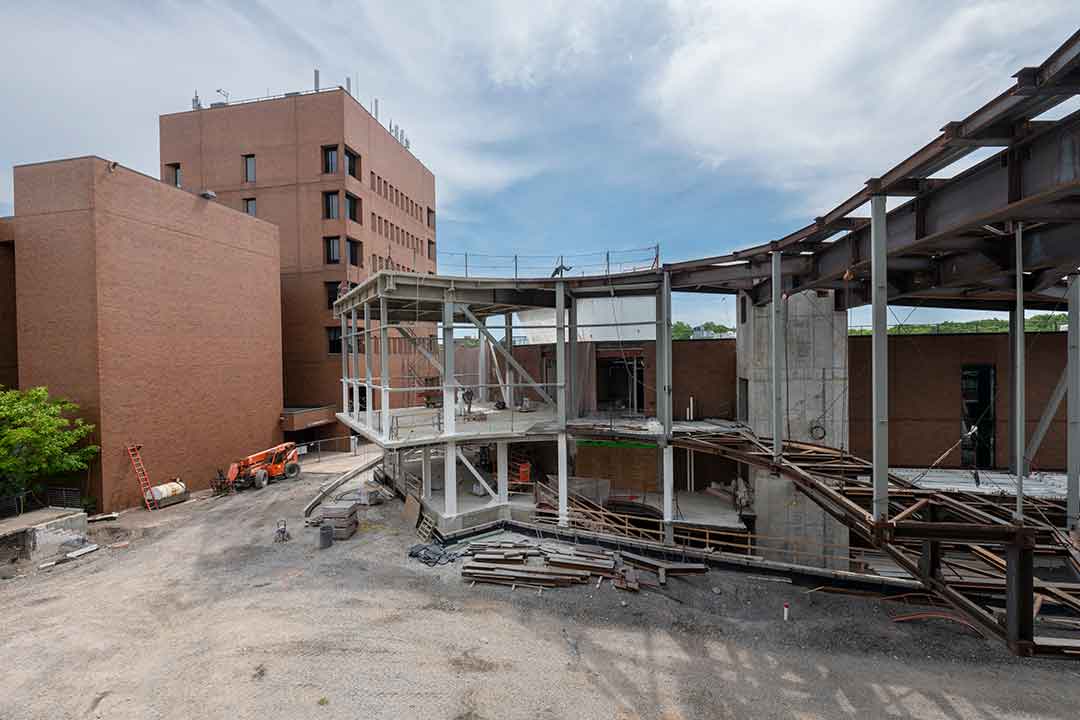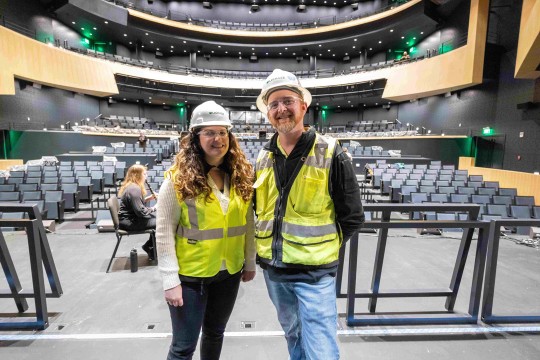Building the SHED: A Q&A with Mark Williams
Elizabeth Lamark
Mark Williams works behind the scenes at RIT to keep the Student Hall for Exploration and Development on track and the campus running.
Construction on the Student Hall for Exploration and Development (SHED) involves hundreds of people and thousands of details, and Mark Williams keeps track of it all.
Williams, RIT principal for construction management, oversees the $120 million project at the center of campus. He’s involved in every aspect from granular to global—from responding to supply chain and product delivery issues to connecting the SHED to the campus network, to keeping the RIT community safe amidst a construction zone.
Elizabeth Lamark
The SHED construction project transforms the RIT campus.
The multi-use complex is an RIT showpiece and one of the most interesting projects Williams has led, he said. The SHED will stretch between Wallace Library and Monroe Hall and extend behind the library to the bus circle, creating an entirely new space on campus with an expanse of glass and interesting architectural features. The complex will house the Brooks H. Bower Maker Showcase, Sklarsky Glass Box Theater, performing arts spaces, and interactive learning classrooms.
Williams is a graduate architect from Miami University with 40 years of experience in hospital and higher-education construction management. He joined RIT 21 years ago and managed the construction of the Golisano building. Since then, Williams has worked on the ESL Global Cybersecurity Institute building, MAGIC Spell Studios building, the Golisano Institute for Sustainability, Clinical Health Sciences, the cadaver lab, the fuel cell lab, the battery lab, the AMPrint Center, the NYSTAR Clean Room, Center for Bioscience Education and Technology, the College of Engineering addition, College of Science’s Bates Study addition, and the University Services Center. Here, Williams shares his insights about working on the SHED.
How do you describe your job?
It varies from moment to moment. Trouble shooting, being sure that the execution of projects occurs and the impact on the campus is appropriate, scheduled, and timely. I’m responsible for the SHED budget. All the money for the project flows through me. I’m accountable to RIT, audit, and essentially to everybody with fiscal responsibilities. It’s all about delivering quality and value.
You’ve done most of the academic construction at RIT in the last 20 years. What is different about the SHED?
This is the most complicated structural project I’ve ever been involved in because of the tie-in points and the different elevations. The building occupies various levels and entry points. The first floor in Wallace and in the SHED are the same. It’s one of the few places where the floors actually line up. There are lots of curves.
What can people look forward to in the SHED?
- The huge atrium in the SHED is about 100 feet tall. I think a lot of people will have a jaw-drop moment when they see the impact of this space.
- The elevations in the SHED, Wallace Library, and Monroe Hall are all different, which makes for dynamic spaces and interesting views. You can see all these vertical shifts when you’re in one space looking back down into another space. There’s a lot of glassed-in connections, a lot of exciting spaces, but it makes for a complicated building process. There are a lot of stairs, changes, and tie-in points, and elevators with half stops and with doors that open and exit on different sides of the elevator depending on which building you’re opening into.
- The glass box theatre has two different glass wall systems with shades that exist within the wall systems.
What will the sound quality be like in the SHED?
The SHED takes sound and acoustics to a new level. We’re building on previous projects. MAGIC Spell Studios started to network together AV to ride on the RIT network. We did a similar thing with the cybersecurity building. It takes AV process and puts it on the network, which makes systems addressable from different locations. You can move signals around from building to building.
We have acoustical professionals who are on our team, and we have specialty people for theatrical AV for the high-end performance spaces. Even in the classrooms, sound isolation and separation have been evaluated, so you’re not getting sound coming in from external spaces.
Elizabeth Lamark
The SHED construction project transforms the RIT campus.
Is the SHED on track to open in fall 2023?
We’re trying to get the certificate of occupation for RIT to start using the building at the end of February next year. The real go-live date is to be ready for fall 2023 classes, but in order to get there we want to have the building ready for turnover so we can get all the maker space equipment, furniture, and AV systems in there, do the punch listing, and satisfy all the verifications and certifications.
There is a lot of technical equipment and special lighting and floors that need to go in the theatrical spaces, music and dance studios, and glass box theatre on the south edge of the building. It all has to be done and tested, and staff need to use it before students get back—so that everybody is comfortable with the new building and all the equipment.
The SHED and Wallace Library will add 27 new classrooms to campus. Can they be used before the official opening?
The only classrooms we are going to put in service in Wallace in the spring semester are five new classrooms on the A level. We have access issues up on the third and fourth floors where most of the classrooms are in Wallace. The problem we have, while the classrooms will be done, is that you can’t get to them safely. We are rebuilding the stair towers in Wallace and putting in two new elevators that connect the SHED and Wallace together and service the third and fourth floors. Everything has to be finished, tested, and fully certified for use.
Elizabeth Lamark
The SHED construction project transforms the RIT campus.
How have supply chain disruptions affected the SHED project?
When you’re trying to build something as big and complicated as the SHED, and with all the landscaping and the site lighting, it’s challenging to work through the product delays. We have to modify plans and it impacts everything. And then there’s the construction workforce. RIT competes with the rest of the area, and the workforce right now is very thin.
I seem to spend a lot of my time thinking about workarounds. It’s figuring out the logistics of how to execute these jobs, keep the campus running, and keep classes in session. It’s all a challenge. It’s the Disney portion of the job—making it work behind the scenes.
From a schedule and budget stand point, we’re solid. We have a well-defined team—the head of the design team locally from HBT, the head of the build team from Welliver, and me. We came up with a plan and it’s moving forward.
What has been your favorite RIT project to manage?
Honestly, I think it will be the SHED. It’s the longest project I’ve ever worked on. I’ve never had a project go more than 16 months. I’ve been on this project since its inception. It will be five years by the time it’s done.






